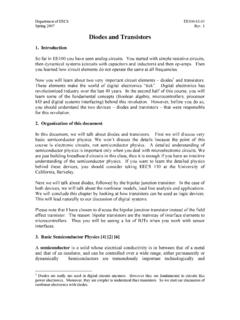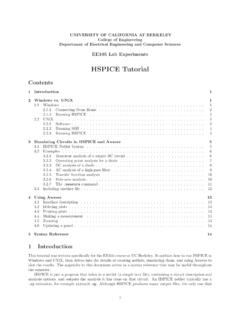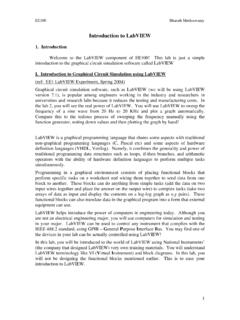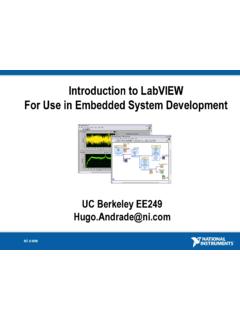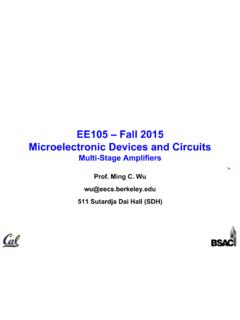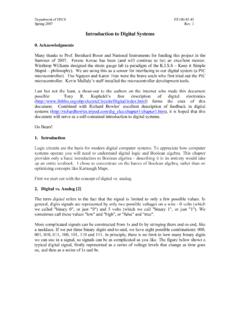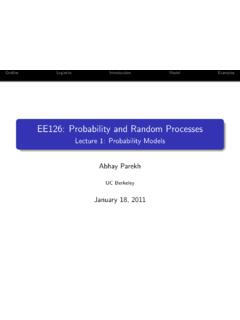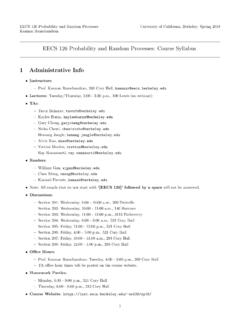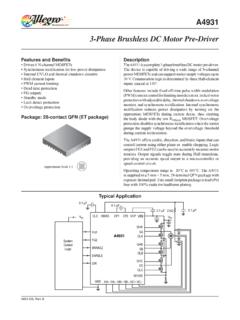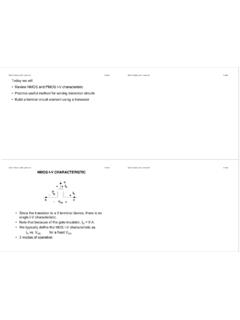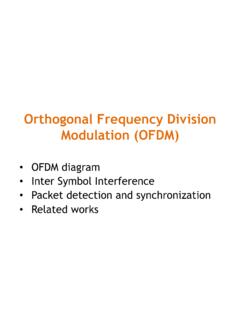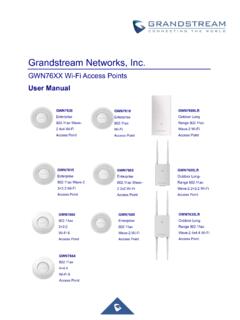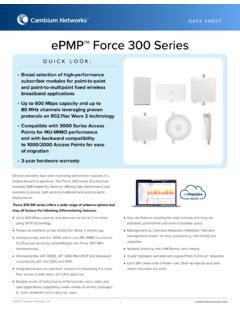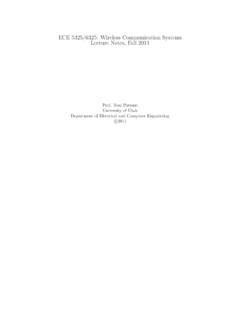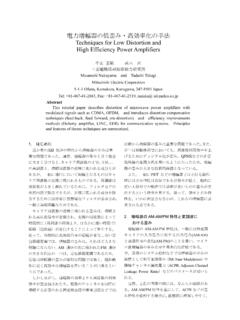Transcription of IEEE 802.11 Wireless LANs - University of California, Berkeley
1 Unit 11 IEEE Wireless LANsShyam ParekhShyam ParekhShyam ParekhShyam ParekhIEEE Wireless LANs References Standards Basics Physical Layer MAC Framing Details Management PCF QoS ( ) Security Take Away PointsTOC Wireless Networks: The Definitive Guide, M. Gast, O Reilly, 2002* ANSI/IEEE Std , 1999 Edition ANSI/IEEE Std ANSI/IEEE Std *Most drawings used in the lectures are from this bookTOC ReferencesIEEE 802 Standards & OSI Model Observe MAC is common to all Physical Layer (PHY) standards PHY is split into Physical Layer Convergence Procedure (PLCP) and Physical Medium Dependent (PMD) sublayersTOC StandardsRelated Standards Bluetooth Originally intended for interconnecting computing and communication devices HIPERLAN European standard for Wireless LANs IEEE Broadband Wireless Addresses needs of fixed and mobile broadband Wireless access replacing fibers, cables, Standards and GHz11 GHz54 GHz54 GHz2 ( )Max RateKey Standards GHz for all above except (referred to as C-Band Industrial, Scientific, and Medical (ISM))
2 Microwave ovens and some cordless phones operate in the same band uses Unlicensed National Information Infrastructure bands GHz GHz GHzTOC StandardsBasic Service Sets (BSSs) Independent BSSs are also referred to as Ad Hoc BSSs Observe that the AP in an Infrastructure BSS is the centralized coordinator and could be a bottleneckTOC BasicsExtended Service Set (ESS) BSSs in an ESS communicate via Distribution System A DS has to keep track of stations within an ESS Inter Access Point protocol (IAPP) is not yet fully standardizedTOC BasicsNetwork Services Distribution Integration Association Reassociation Disassociation Authentication Deauthentication Privacy MAC Service Data Unit (MSDU) deliveryTOC BasicsSeamless Transition Seamless transition between two BSSs within an ESS Between ESSs, transitions are not supportedTOC : HR/DSSS*PHY Use Complementary Code Keying (CCK) instead of Differential Quadrature Phase Shift Keying (DQPSK) used at lower rates Provides good performance in presence of interference and multipath fading 4-bit (for Mbps) or 8-bit (for 11 Mbps) symbols form MAC layer arrive at million symbols per second Each symbol is encoded using CCK code word {ej( 1+ 2+ 3+ 4), ej( 1+ 3+ 4), ej( 1+ 2+ 4), ej( 1+ 4), ej( 1+ 2+ 3), ej( 1+ 3), ej( 1+ 2), ej 1} 1, 2, 3, and 4 are decided by symbol bits*High Rate Direct-Sequence Spread SpectrumTOC Physical Layer : HR/DSSS PHY - 2 Uses same channels as by the low rate DS In US, channels 1-11 (with center frequencies at GHz and 5 MHz distance) are available For 11 Mbps, Channels 1, 6, and 11 give maximum number of channels with minimum interferenceTOC Physical Layer : HR/DSSS PHY - 3 Long PLCP format Optional Short PLCP format is offered for better efficiencyTOC Physical Layer.
3 5 GHz ofdm PHY Fundamental orthogonal frequency division multiplexing ( ofdm ) work was done in 1960s, and a patent was issued in 1970 Basic idea is to use number of subchannels in parallel for higher throughput Issues with Denser Access Point deployment needed due to higher path loss Higher power needTOC Physical Layer : 5 GHz ofdm PHY - 2 ofdm is similar to frequency division multiplexing except it does not need guard bands But need guard times to minimize inter-symbol and inter-carrier interference Relies on orthogonality in frequency domainTOC Physical Layer : 5 GHz ofdm PHY - 3 In , there are 12 channels, each 20 MHz wide Spectrum layoutTOC Physical Layer : 5 GHz ofdm PHY - 4 Each channel is divided into 52 subcarriers: 48 are used for data PLCP Protocol Data Unit (PPDU) format PHY uses rate of 250K symbols per second Each symbol uses all 48 subcarriers Convolution code is used by all subcarriersTOC Physical Layer : 5 GHz ofdm PHY - 5 Modulation and CodingMAC: Access Modes MAC Access Modes: Distributed Coordination Function (DCF) Based on Carrier Sense Multiple Access/Collision Avoidance (CSMA/CA) Point Coordination Function (PCF) Restricted to Infrastructure BSSs Not widely implemented Access Point polls stations for medium accessTOC MACMain Ideas of MAC: CSMA/CA Interframe Spacing (IFS) Short IFS: For atomic exchanges PCF IFS: For prioritized PCF access DCF IFS: For Normal DCF access Extended IFS: For access after error Medium AccessTOC MACMain Ideas of MAC.
4 CSMA/CA - 2 If medium is idle for DIFS interval after a correctly received frame and backoff time has expired, transmission can begin immediately If previous frame contained errors, medium must be free for EIFS If medium is busy, access is deferred until medium is idle for DIFS and exponential backoff Backoff counter is decremented by one if a time slot is determined to be idle Unicast data must be acknowledged as part of an atomic exchangeTOC MACI nterframe Spacing Interframe Spacing values are physical layer dependent SIFS and Slot_Time are explicitly specified, and the others are derived PIFS = SIFS + Slot_Time DIFS = SIFS + 2 Slot_Time EIFS = SIFS + DIFS + (Ack_Time @ 1 Mbps) For and SIFS is 16 s and 10 s, respectively Slot_Time is 9 s and 20 s, respectivelyTOC MACC ontention Window Backoff is performed for R slots: R is randomly chosen integer in the interval [0, CW] CWmin CW CWmax CWmin= 31 slots and CWmax= 1023 slots (for ) Up to CWmax, CW = (CWmin+ 1) 2n 1, where n = 0, 1, 2.
5 Is (re)transmission numberTOC MACE rror Recovery Each frame is associated with a retry counter based on frame size as compared to RTS/CTS threshold Short retry counter Long retry counter Fragments are given a maximum lifetime by MAC before discarding themTOC MACWLAN Problems Hidden Terminal and Exposed Terminal problemsTOC MACRTS/CTS Clearing RTS/CTS Clearing Used for frames larger than RTS/CTS threshold Tradeoff between overhead and retransmission costsTOC MACV irtual Carrier Sensing Virtual Carrier Sensing using Network Allocation Vector (NAV)TOC MACF ragmentation Burst Fragmentation and RTS/CTS thresholds are typically set to the same valueTOC MACF raming Details: Format Generic MAC Frame FrameControl Field Sequence Control FieldTOC Framing DetailsFraming Details: Frame Types Type and Subtype Identifiers Management Frames Control Frames Data FramesTOC Framing DetailsBroadcast/Multicast No Acknowledgements for Broadcast or Multicast framesTOC Framing DetailsNAV for Fragmentation Fragmentation threshold provides tradeoff between overhead and retransmission costs Chaining of NAV to maintain control of the mediumTOC Framing DetailsNAV for RTS/CTS and Power Save (PS)-Poll RTS/CTS Lockout Immediate PS-Poll Response Deferred PS-Poll Response+ CTSTOC Framing DetailsData Frames and Addresses Generic Data Frames Addressing and DS Bits BSSID is MAC address of AP WLAN interfaceTOC Framing DetailsIllustrations of use of Addresses Frames to Distribution System Frames from Distribution System Wireless Distribution SystemTOC Framing DetailsRTS/CTS Control Frames RTS Frame CTS FrameTOC Framing DetailsAck and PS-Poll Control Frames Acknowledgement Frame Power-Save Poll (PS-Poll)
6 FrameTOC Framing DetailsManagement Frames Generic Management FramesTOC Framing DetailsFixed-Length Management Fields Beacon Interval Field In 1024 s Time Units (TUs) Typically 100 TUs or about Seconds Capability Information Used in Beacon, Probe request and Probe Response FramesTOC Framing DetailsFixed-Length Management Fields - 2 Listen Interval Number of Beacon Intervals a station waits before listening to Beacon frames Timestamp Allows synchronization Number of microseconds timekeeper has been activeTOC Framing DetailsManagement Information Elements Generic Management Frame Information Element Service Set Identity (ASCII Identifier) DS Parameter Set Contention Free Parameter SetTOC Framing DetailsMain Management Frames Beacon Frame Probe Request Frame Probe Response FrameTOC Framing DetailsMain Management Frames - 2 Authentication Frames Association Request (Re)Association ResponseTOC Framing DetailsManagement Operations: Scanning Passive Scanning Active ScanningTOC ManagementManagement Operations:Authentication and Association Shared key Authentication Exchange Makes use of WEP Association ProcedureTOC ManagementManagement Operations:Buffered Frame Retrieval Unicast Buffered Frames Broadcast and Multicast Buffered FramesTOC ManagementPCF: Mechanism AP polls stations on its list, and maintains control of the medium Announces CFPMaxDuration in Beacon Transmissions are separated by PIFS Each CF-Poll is a license for one frame Basic PCF exchanges and timing Foreshortening of Contention Free PeriodTOC PCFPCF Frames Usage of Data + CF-Ack + CF-Poll CF-Poll Usage Data, Ack, and Poll can be combined in one frame Data and Poll must be for the same stationTOC PCFPCF Frames - 2 CF-Ack + CF-Poll Usage CF End CF Parameter Set Count/Period in DTIM intervals, Duration in TUsTOC PCFQoS.
7 Shortcomings of PCF PCF falls short of guaranteeing desired QoS due to Beacon frame delays beyond Target Beacon Transition Time (TBTT) Unpredictable demand from the polled station proposes an enhanced MAC protocolTOC QoS ( )Enhanced DCF of Introduces Traffic Categories (TCs) Following attributes are functions of TC AIFS (arbitration IFS) CWminand CWmax PF (Persistence Factor) TXOP (Transmission Opportunity) Start Time & DurationTOC QoS ( )Intra-station Virtual Backoff ( ) Intra-Station backoff to differentiate QoS across TCsTOC QoS ( )Hybrid Coordination Function of Hybrid Coordination (HC) can initiate polling during contention period using PIFS HC can learn desired TXOPs by mobile stations HC uses own scheduling algorithmsTOC QoS ( )Security Goals Security solution should provide Confidentiality Authentication Integrity Maintain processing required to reasonable levelsTOC SecuritySecurity: States of Mobile Stations Authentication and Association States Allowed frames depend on the state Class 1 Frames Class 2 Frames Class 3 FramesTOC SecurityWired Equivalent Privacy (WEP) Based on Symmetric Secret Key A Keystream is created using the Secret Key Generic Stream Cipher OperationTOC SecurityWEP Encipherment WEP uses 40 bit RC4 secret key and 24 bit Initialization Vector (IV)
8 Crucial aspect is how to create Keystream using Pseudorandom Number Generator WEP Frame Extensions Frame body and ICV are encryptedTOC SecurityWEP Decipherment WEP Decipherment using Symmetric Secret KeyTOC SecurityWEP based Authentication WEP based authentication using Secret KeyTOC SecurityWEP Flaws Secret key distribution Cipher Stream creation needs to be based true random generator ICV collision allows attacker to decipher A weak class of keys and known first byte of payloadTOC Authentication provides strong authentication Based on IETF s Extensible Authentication Protocol (EAP) EAP Packet FormatTOC Architecture Architecture Typical EAP Exchange EAP can also be used for Dynamic Key exchangeTOC SecurityFlaws of Session Hijacking Man-in-the-middle attacks Denial of service attacks ..TOC SecurityTake Away Points Hidden and exposed terminals MAC based on a CSMA/CA strategy Medium access scheme RTS/CTS NAV Differences with Ethernet Access prioritization with different IFSs RTS/CTS/Data/Ack atomic exchange Don t need to remember Frame formats Physical layer details (modulation, etc.)
9 Details Parameter values (will be provided if required for a problem) See Wi-Fi Study Guide on the class syllabus page for more informatio
